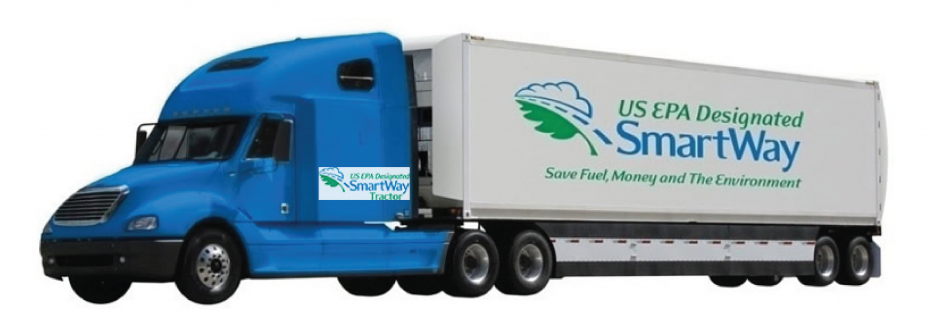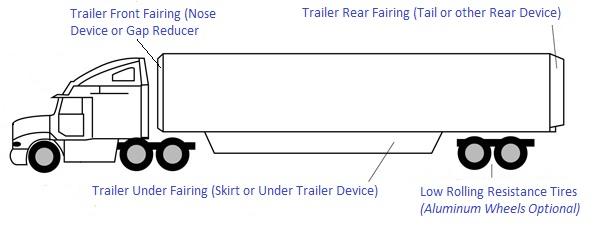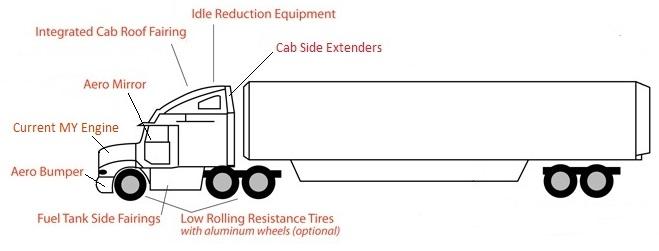SmartWay Designated Tractors and Trailers
Finding the right truck is critical to maximizing freight efficiency – using a SmartWay designated tractor and trailer can reduce fuel use by up to 20 percent 2,000 to 4,000 gallons of diesel per year!

SmartWay and SmartWay Elite Trailers
- SmartWay; and
- SmartWay Elite.
Both trailers use verified low rolling resistance tires – the difference is the level of aerodynamics and the resulting total fuel savings.
The specifications are summarized in the table below:
| SmartWay Trailer | SmartWay Elite Trailer | |
|---|---|---|
| Tires | Verified Low Rolling Resistance Tires (1% fuel savings) | |
| Aerodynamic Devices | One or more devices (at least 5% fuel savings) |
Combination of two or more devices (at least 9% fuel savings) |
| Total Fuel Savings | 6% or more | 10% or more |
SmartWay Designated Trailer with Aerodynamic and Tire Components:

Finding SmartWay Designated Trailers
Highlight
- Fleets can retrofit an existing trailer with:
- SmartWay Verified Tires and;
- Aerodynamic Devices.
- Check Examples of SmartWay Designated Trailer Configurations for more information)
- Fleets can also purchase a new trailer with aerodynamic packages from the following trailer manufacturers:
| Manufacturer |
|---|
| Great Dane Trailers |
| Hyundai Translead |
| Manac Inc. |
| Stoughton Trailers, LLC |
| Strick Trailers, LLC |
| Utility Trailer Manufacturing Company |
| Vanguard National Trailer Corporation |
| Wabash National Corporation |
| Wilson Trailer Co. |
SmartWay Tractors
SmartWay tractors have been demonstrated to be the most fuel-efficient Class 8 models for long-haul freight movement. See below for sample components of the SmartWay Designated Tractor:

| Component | Specifications |
|---|---|
| Engine |
|
| Aerodynamics |
|
| Tires |
|
|
Idle Reduction |
At least one of the following no-idle to provide at least eight hours of idle-free
|
To Designate a Tractor
- Ensure that your tractors have the above features
- Contact Tech_Center@epa.gov with your company's name and tractor(s) details
Finding SmartWay Tractors
Highlight
The following tractor models are SmartWay Designated
| Manufacturer | Tractor Model | Model Year |
|---|---|---|
| Navistar | ProStar, ProStar+ | 2007, or newer |
| Navistar | 9200i | 2007, 2008 & 2009 |
| Navistar | LoneStar | 2008, or newer |
| Mack | Pinnacle | 2008, or newer |
| Daimler | Columbia | 2008, or newer |
| Daimler | Century Class S/T | 2008, or newer |
| Daimler | Cascadia | 2008, or newer |
| Volvo | VN 630 | 2007, or newer |
| Volvo | VN 670 | 2007, or newer |
| Volvo | VN 780 | 2007, or newer |
| Kenworth | T2000 | 2008, 2009, 2010 & 2011 |
| Kenworth | T660 | 2008, or newer |
| Kenworth | T680 | 2012, or newer |
| Kenworth | T700 | 2011 or newer |
| Peterbilt | 387 | 2008, 2009, 2010 & 2011 |
| Peterbilt | 386 | 2008, or newer |
| Peterbilt | 384 | 2010, or newer |
| Peterbilt | 587 | 2011, or newer |
| Peterbilt | 579 | 2012, or newer |
| Western Star | 5700XE | 2016, or newer |
| International | LT | 2016, or newer |
- EPA does not endorse the products or services of commercial companies. Any reference to a specific commercial product or service by trade name, trademark, manufacturer, company, or otherwise does not constitute or imply the endorsement or recommendation of EPA.
- Fuel savings estimates are based upon extensive research, fleets, and the input of industry and scientific associations. However, your increase in freight efficiency will depend upon several factors including your operations and the fuel-efficiency of your starting vehicles.
- All equipment must be maintained per manufacturer’s service recommendations and replaced when necessary.
